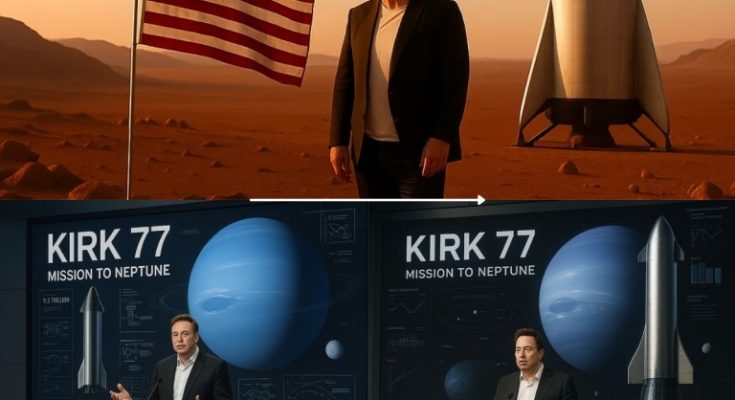 Humanity’s Boldest Leap Yet
Humanity’s Boldest Leap Yet
When Elon Musk takes the stage, the world listens. From the first Falcon 1 launch to the first reusable rocket landing, from the dream of Mars colonization to the creation of global satellite internet, his announcements have repeatedly shifted the trajectory of technology and human ambition. But nothing — not even Mars — compares to what he just unveiled.

In a stunning announcement that sent shockwaves through the scientific community, Musk revealed plans for “KIRK 77,” a $3 trillion mission to Neptune — the farthest ice giant in our solar system and one of the most mysterious worlds ever discovered. The mission, he said, is not just about exploration. It’s about redefining humanity’s place in the universe.
“Mars was never the finish line,” Musk declared during the announcement at SpaceX headquarters in Hawthorne, California. “It was just the beginning. With KIRK 77, we’re extending the reach of human civilization to the edge of our solar system — and what we learn there could transform life here on Earth.”
 Why Neptune?
Why Neptune?
For decades, Neptune has been the “forgotten frontier” of planetary science. Discovered in 1846, it is the eighth and farthest planet from the Sun, a frigid world 4.5 billion kilometers from Earth, shrouded in methane clouds and surrounded by faint rings. It’s been visited only once — by NASA’s Voyager 2 in 1989 — and much of its composition, weather patterns, magnetic field, and moons remain a mystery.
But to Musk and the SpaceX team, Neptune represents more than a scientific curiosity. It is a potential treasure trove of knowledge and resources that could redefine humanity’s technological future.
“We believe Neptune is the key to the next era of science and industry,” said Gwynne Shotwell, SpaceX President and COO. “Its magnetic field, its atmosphere, and its moons hold clues that could unlock breakthroughs in energy, propulsion, communications — even our understanding of the universe itself.”
 The Mission: “KIRK 77”
The Mission: “KIRK 77”
The name KIRK 77 is more than a nod to ambition. It’s a symbolic fusion of Charlie Kirk’s advocacy for bold exploration and SpaceX’s long-standing mission to push humanity beyond its limits. According to Musk, the project represents “the largest, most expensive, and most ambitious private space mission ever attempted.”
Key Details of the Mission:
- Budget: $3 trillion over 25 years — funded by a mix of SpaceX revenue, private investors, sovereign space partnerships, and new commercial ventures.
- Timeline: Launch window targeted for 2040, with spacecraft departure expected around 2042 and arrival at Neptune by 2060.
- Spacecraft: A next-generation fusion-powered interplanetary vessel — codenamed Odyssey — capable of sustained acceleration and onboard AI-assisted navigation.
- Crew: Initial missions will be robotic and autonomous, with potential crewed expeditions by the 2070s.
- Primary Objectives: Study Neptune’s atmosphere, map its magnetic field, analyze its 14 known moons (including Triton), and investigate potential for helium-3 harvesting and resource extraction.
 Why $3 Trillion?
Why $3 Trillion?
The figure stunned many observers. Even the Apollo Program, adjusted for inflation, cost around $280 billion. Musk’s Neptune plan is more than 10 times that — a colossal financial undertaking unlike anything in history.
Yet, SpaceX argues the cost is justified by the scale of potential returns.
- Helium-3 for Clean Fusion: Neptune’s upper atmosphere is believed to contain vast quantities of helium-3, a rare isotope that could revolutionize fusion energy — providing virtually limitless, clean power.
- New Propulsion Technologies: The mission’s development of next-generation fusion drives and solar sails could slash travel times across the solar system, enabling missions to Saturn, Uranus, and beyond.
- Climate Solutions: Data on Neptune’s dynamic weather systems and methane distribution could inform new strategies for climate modeling and carbon management on Earth.
- Communications Revolution: The mission will deploy advanced relay satellites capable of deep-space quantum communication, paving the way for near-instant data transfer across billions of kilometers.
“This isn’t a science project — it’s a civilization project,” Musk said. “It’s about laying the groundwork for a future where humanity is not limited to one planet or one star.”
 From Mars to the Ice Giants: A New Vision
From Mars to the Ice Giants: A New Vision
For years, Musk’s dream of colonizing Mars has captured the public imagination. But in recent months, he’s hinted that Mars was never the final destination — only the next step. The Neptune mission signals a dramatic expansion of SpaceX’s long-term vision: one that looks beyond habitability and focuses on capability.
“We’re not going to Neptune to live there,” Musk clarified. “We’re going to Neptune because what we discover there could change how we live here — and how we explore everywhere else.”
This shift reflects a broader trend in space exploration. While NASA, SpaceX, and other private companies continue to prioritize Mars, there is growing interest in the outer planets — not as homes, but as laboratories. These ice giants may hold the keys to fundamental physics, planetary formation, and new frontiers in resource science.
 Scientists Are Buzzing
Scientists Are Buzzing
The scientific community’s reaction has been one of cautious excitement. Many experts see KIRK 77 as an unprecedented opportunity to answer questions that have lingered for decades.
Dr. Serena Hollis, a planetary scientist at Caltech, called the mission “the most significant leap in planetary exploration since Voyager.”
“We know almost nothing about Neptune’s interior, its weather systems, or its magnetic field,” Hollis explained. “A dedicated mission could transform our understanding of planetary physics — and give us insights into exoplanets that are similar in size and composition.”
Others point to Triton, Neptune’s largest moon, as a particularly enticing target. Believed to be a captured Kuiper Belt object, Triton could contain subsurface oceans and even microbial life — making it one of the most promising places to search for life beyond Earth.
 The Economic Stakes
The Economic Stakes

While the scientific value is enormous, the economic implications of KIRK 77 may be even greater. Space mining, clean energy, and advanced propulsion are trillion-dollar industries in their own right — and Neptune could accelerate all three.
Venture capitalist Arjun Patel described the mission as “the most significant investment in the future of civilization.”
“This is not a moonshot — it’s a solar system shot,” Patel said. “If SpaceX can harvest even a fraction of the helium-3 or pioneer the propulsion technologies they’re talking about, it could reshape the global economy.”
Investors are already circling. Following the announcement, SpaceX’s private valuation reportedly surged past $1.3 trillion, with speculation that the company may seek the largest IPO in history to fund the mission.
 Challenges and Skepticism
Challenges and Skepticism
Despite the excitement, the plan is not without critics. Many question the feasibility of a $3 trillion mission, especially given current technological limitations.
- Travel Time: Even with advanced propulsion, a journey to Neptune could take 15 to 20 years.
- Extreme Conditions: Temperatures near -220°C, intense winds exceeding 2,000 km/h, and powerful magnetic storms make exploration risky.
- Cost Overruns: Large-scale space missions often exceed budgets — sometimes by hundreds of billions.
- Ethical and Environmental Concerns: Some argue that such vast resources should be directed toward solving Earth’s problems first.
“Elon Musk is a visionary,” said Dr. Robert Malik, a space policy expert. “But this mission pushes the boundaries of what’s economically and politically possible. It’s not clear whether governments, investors, or the public will support a project on this scale.”
 A New Space Age Begins
A New Space Age Begins
Yet even skeptics acknowledge that Musk’s announcement marks a turning point in human ambition. For centuries, humanity has dreamed of reaching beyond the inner solar system. Now, for the first time, that dream has a roadmap.
If successful, KIRK 77 will represent more than a milestone — it will redefine what is possible for our species. It will signal that humanity has evolved from explorers of planets to architects of a solar civilization.
And just as Apollo inspired generations in the 20th century, Neptune could become the rallying cry of the 21st.
 “The Future Belongs to the Bold”
“The Future Belongs to the Bold”
As the press conference ended, Musk was asked a question that echoed through the auditorium: Why Neptune? Why now?
His answer was simple, but it carried the weight of everything SpaceX has built and everything humanity still hopes to achieve:
“Because it’s there. Because it’s hard. And because the future belongs to those who refuse to stop reaching.”
 Final Thoughts: The Dawn of the Deep-Space Era
Final Thoughts: The Dawn of the Deep-Space Era
The announcement of KIRK 77 is more than a headline — it’s a declaration of intent. It says that humanity will not be confined to Earth, or Mars, or even the asteroid belt. It says we are ready to stretch our reach to the farthest corners of our solar system — not for glory, but for knowledge, progress, and survival.
It’s a reminder that every great chapter in human history began with an idea that seemed impossible.
Today, that idea is a mission to Neptune. Tomorrow, it could be a colony on Europa. A research station on Titan. A voyage beyond the heliopause.
But for now, the focus is on KIRK 77 — a mission that dares to ask the ultimate question: How far are we willing to go to secure the future of our species?



